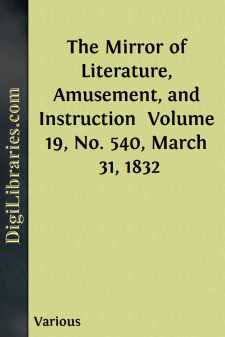Categories
- Antiques & Collectibles 13
- Architecture 36
- Art 48
- Bibles 22
- Biography & Autobiography 813
- Body, Mind & Spirit 142
- Business & Economics 28
- Children's Books 14
- Children's Fiction 11
- Computers 4
- Cooking 94
- Crafts & Hobbies 4
- Drama 346
- Education 46
- Family & Relationships 57
- Fiction 11829
- Games 19
- Gardening 17
- Health & Fitness 34
- History 1377
- House & Home 1
- Humor 147
- Juvenile Fiction 1873
- Juvenile Nonfiction 202
- Language Arts & Disciplines 88
- Law 16
- Literary Collections 686
- Literary Criticism 179
- Mathematics 13
- Medical 41
- Music 40
- Nature 179
- Non-Classifiable 1768
- Performing Arts 7
- Periodicals 1453
- Philosophy 64
- Photography 2
- Poetry 896
- Political Science 203
- Psychology 42
- Reference 154
- Religion 513
- Science 126
- Self-Help 84
- Social Science 81
- Sports & Recreation 34
- Study Aids 3
- Technology & Engineering 59
- Transportation 23
- Travel 463
- True Crime 29
The Mirror of Literature, Amusement, and Instruction Volume 19, No. 540, March 31, 1832
by: Various
Categories:
Description:
Excerpt
BANKSIDE.—OLD THEATRES.
The ancient topography of the southern bank of the Thames (or Bankside) between London and Blackfriars bridges is peculiarly interesting to the lover of dramatic lore, as well as to the inquirer into the sports and pastimes of our ancestors. It appears to have been the Arcadia of the olden metropolis, if such a term be applicable to a place notorious for the indulgence of brutal sports.
The Cut in the adjoining column represents Bankside in 1648, from which it appears to have been then in part waste and unenclosed. "It was land belonging to the crown, and on various parts of it stood the Globe Theatre, the Bear Garden, and other places of public show; here were also the Pike Gardens, some time called the Queen's Pike Gardens, with ponds for the preservation of fresh-water fish, which were said to be kept for the supply of the royal table, under the inspection of an officer, called the king's purveyor of pike, who had here a house for his residence." On the Bankside, prior to the above date, were also the ancient Bordello, or Stews, which, according to Pennant, were distinguished by their respective signs painted against the walls, one of which, in particular, was the Cardinal's Hat; and a small court, now or till lately called Cardinal's Hat Court, still exists on the Bankside, and probably shows the precise site of the mansion of depravity. In like manner we find on Bankside, Pike Garden, Globe Alley, and in the vicinity a public-house with the sign of the Globe. On Bankside also stood an ancient Hall and Palace of the Bishops of Winchester, stated to have been built by William Gifford, Bishop of Winchester, about the year 1107, on a piece of ground belonging to the Prior of Bermondsey, to whom was paid a yearly acknowledgment. The great court, at one time belonging to this palace, is still known by the name of Winchester Square, and in the adjacent street was, some time since, an abutment of one of the gates. Near this Palace, on the south, at one time stood the Episcopal Palace of the Bishops of Rochester; which is supposed to have bequeathed its name to Rochester Street. The whole of the Bank shown in the Cut is now densely populated, and scarcely a pole of green sward is left to denote its ancient state. On the opposite or Middlesex bank may be distinguished the celebrated Castle Baynard.
The second Cut represents the BULL and BEAR-BAITING THEATRES, as they appeared in their first state, A.D. 1560. This spot was called Paris Garden, and the two theatres are said to have been the first that were formed near London. In these, according to Stow, were scaffolds for the spectators to stand upon, an indulgence for which they paid in the following manner: "Those who go to Paris Garden, the Bell Savage, or Theatre, to behold bear-baiting, enterludes, or fence-play, must not account of any pleasant spectacle unless they first pay one penny at the gate, another at the entrie of the scaffold, and a third for quiet standing." One Sunday afternoon, in the year 1582, the scaffold, being overcharged with spectators, fell down during the performance, and a great number of persons were killed or maimed by the accident, which the puritans of the time failed not to attribute to a Divine judgment....












